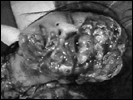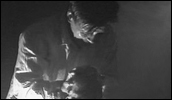The Mermaid in the Manhole
- Year
- 1991
- Original title
- Za Ginipiggu Manhoru no naka no Ningyo
- Japanese title
- ザ・ギニピッグ マンホールの中の人魚
- Alternative title
- Mermaid in a Manhole
- Director
- Cast
- Running time
- 57 minutes
- Published
- 20 March 2001



by Tom Mes
Along with sadisitc TV game shows, the Guinea Pig series of cheaply-shot straight-to-video grand guignol horror movies is one of the most infamous and extreme examples of what some see as the depraved nature of Japanese popular culture. The series gained its notoriety when actor Charlie Sheen was allegedly shown a copy of part 2, Flower of Flesh and Blood - the story of a deranged murderer who dissects a young woman in his basement one bit at a time in gory, graphic detail - and believed it to be a genuine snuff film.
Sheen reported his concerns to the FBI, who undertook a thorough investigation before arriving at the inevitable conclusion that the film was a fake. The damage was already done, however, and cultural xenophobes had found more proof that the minds of the Japanese were depraved and corrupted, while Western gorehounds had another title to put at the top of their wish lists.
The Guinea Pig films were a series of short, fictional features devised by producer Satoru Ogura and manga artist Hideshi Hino, known in the West for his critically praised comic book Panorama of Hell. Hino's effort provoked police investigations in both the US and Japan, where Flower of Flesh and Blood was thought to be connected to a serial killer case. The rumour goes that in an attempt to dispell the notion that the Guinea Pig films were genuine snuff, producer Ogura created a 'making of' episode documenting the creation of the films' make-up and gore effects, courtesy of fx artist Nobuaki Koga. Whatever the story, the link between the real-life crimes and video violence led more or less directly to the creation of a style of horror that relied more on atmosphere than gore, a style that would years later be dubbed 'J-horror' (see our interview with founding father Norio Tsuruta for more on J-horror's origins)
Shortly after the controversy, the rights to Guinea Pig were acquired by distributors JHV and the series went into different territories as the films became more plot-driven, more humorous and generally traded the gory for the absurd.
The first of the JHV cycle, episode four in total, was once again directed by Hideshi Hino. Surprisingly, Hino delivered a film rich in themes and subtexts and which, despite being incredibly graphic, wasn't really about violence. With The Mermaid in the Manhole the director above all chose to explore the theme of human obsession and devotion which go beyond sickness, decay and death.
The story concerns a painter whose wife has recently left him. He devotes all his time and attention to his art, venturing into the sewers beneath his house in search of inspiration for his paintings, which all depict scenes of decay and disease. Once this sewer was a river, where the painter played as a child and where he believes he once saw a mermaid. On one of his treks down into the filthy stream, he realises that his beliefs were right when he discovers the mermaid, trapped in the stinking sewer. When the river ran dry, she explains, she was unable to get back to sea and hid in the sewer system. Her skin badly infected after years of contact with waste and pollution, she begs the painter to help her. He decides to take her to his house, where he places her in his bathtub and proceeds to paint her portrait.
Her condition worsens and after a while festering sores start erupting all over her body. Though both of them know that death is inevitable, the mermaid asks the artist to document her decay in his painting. This he does and the bond between the two grows stronger as her situation deteriorates. When the sores increase, he adjusts his portrait accordingly, even when the infection turns into a grotesque mutation that covers her entire body. When he fails to find the right paint to truthfully depict the colours of her infections, she tells him to slice open the boils with a razor blade and use the abundantly flowing puss instead.
The Mermaid in the Manhole is a perverted fairy tale, but one which exists to celebrate the spiritual connections that can exist between two people. It celebrates love and devotion, between two human beings, but also between the artist and his art, and between the artist and his muse. With the obvious nods to Oscar Wilde's The Picture of Dorian Gray, comments on environmental pollution, and Cronenberg-esque fascination with disease and the frailty of the human body (also an important factor in his two earlier Guinea Pig outings), Hideshi Hino has created an unexpectedly absorbing and fascinating study of obsession and deep-rooted devotion - at least for those with stomachs strong enough to retain their composure at the displays of day-glo coloured decay.